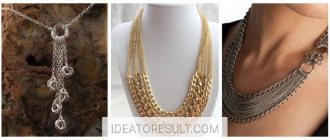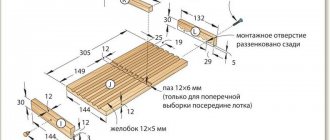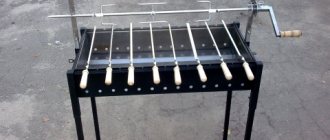Self-production of sprockets for bicycle structures
Self-production of sprockets for bicycle structures
Andre » Jan 31, 2016 09:39 pm
Hello everyone, peace to your homes! Actually, here is my latest work from 2015. Next will be photos. Briefly: I made a 36-teeth drive sprocket for a high-speed bicycle, the work was done at home from what I had. And there was a sheet of metal 2 mm thick and of a suitable area. There was also a green toad to pay as much as 500 rubles for the front triple sprocket from the store, especially since wear killed only the middle sprocket with 38 teeth. Why did I do it at 36? Yes, everything is as simple as a clear day! Marking every 10 degrees around the circumference. I am not attaching a photo of the markings. Everything is so simple there. If you have knowledge of working with drawings on a computer, then making markings for any number of teeth is no problem. I drew with a pencil and a protractor. Go!
1 photo: Marking with a sharp core and starting drilling in two stages, stage 1 with a 4 mm drill, stage 2 with an 8 mm drill. (2nd photo) Drilled with a hand drill. Those who have a drilling machine find it easier, of course. But what happened. Drilling in two stages was dictated by the fact that, firstly, it is difficult to drill 8 mm at once with a hand drill, and secondly, that the risk of a large drill jumping off the mark made with a core is very high. And a mistake at the very beginning, even by 1 mm, will reduce all efforts and efforts to nothing!
Self-production of sprockets for bicycle structures
by Andre » Jan 31, 2016 09:54 pm
Self-production of sprockets for bicycle structures
Andre » Jan 31, 2016 10:59 pm
Self-production of sprockets for bicycle structures
Andre » Jan 31, 2016, 11:07 pm
Self-production of sprockets for bicycle structures
Andre » Jan 31, 2016 11:24 pm
Self-production of sprockets for bicycle structures
Andre » Jan 31, 2016 11:29 pm
Self-production of sprockets for bicycle structures
Andre » Jan 31, 2016 11:33 pm
Drilling the center and mounting holes.
This was my first successful job of making such a part. Before this, there was an attempt to make a star from a small saw blade (samokal), but during drilling the drill was allowed to shift. Since there was no point in working with the disk further, I started working on another workpiece. When marking and marking points for future holes, I strongly recommend fixing the paper with markings in SEVERAL places to the metal, either with magnets or clothespins. Since hitting the core with a hammer may cause the paper to move out. It’s better, of course, for the sheet of metal to lie (and be fixed (with clamps or screws all the way through)) on a stable board. Alternatively, you can make markings on thin plywood. In this case, through this plywood, you will need to drill and not core. In general, the main thing is not to rush And also, I later figured out that when making a star, you can drill holes in two sheets of metal at once. I would not recommend using more than two sheets of metal when drilling with a hand-held electric drill, since as the drilling depth increases, the perpendicularity of the drill to the workpiece will affect the lower stars. However, if you have a drilling machine, this problem disappears. And here you can drill 3 or 4 blanks. If you wish, the star can be painted, or made from stainless steel. I plan to make stars on the front of a different size. Multiples of whole degrees when marking the circle. I hope This material will be of interest to someone. Safe roads and fair winds to everyone! And warmth in the houses, of course! Andrey from Labinsk.
Self-production of sprockets for bicycle structures
kab » 01 Feb 2016, 16:17
Self-production of sprockets for bicycle structures
Andre » 02 Feb 2016, 16:26
Self-production of sprockets for bicycle structures
kab » 05 Feb 2016, 12:47
Re: Making your own sprockets for bicycle designs
Andre » Jul 18, 2022, 11:35 pm
Actually, hello everyone: The sprocket I made has been running for 7,000 km. And I think it will end somewhere after 10 thousand km.
Here I am posting my calculations made using an online calculator:
SPROCKET CALCULATION: Chain pitch 12.7 mm.
With 15 teeth: marking angle 24 degrees / Drilling radius 32.97 mm = 12.710 mm ///
With 18 teeth: marking angle 20 degrees / Drilling radius 36.6 mm = 12.711 mm ///
With 20 teeth: marking angle 18 degrees / Drilling radius 41.6 mm = 12.702 mm ///
With 24 teeth: marking angle 15 degrees / drilling radius 48.7 mm = 12.713 mm ///
With 30 teeth: marking angle 12 degrees / drilling radius 60.8 mm = 12.711 mm ///
With 36 teeth: Marking angle 10 degrees drilling radius 72.9 mm = 12.707 mm ///
With 40 teeth: marking angle 9 degrees / drilling radius 81 mm = 12.710 mm ///
With 45 teeth: marking angle 8 degrees / drilling radius 91.1 mm = 12.710 mm ///
With 48 teeth: marking angle 7.5 degrees // drilling radius 97.1 mm - 12.701 mm (97.2 mm = 12.714) ///
At 60 teeth: marking angle 6 degrees / Drilling radius 121.4 mm = 12.707 mm, (121.5 mm = 12.714)
The fact is that the construction of markings on paper begins with drawing the required number of rays emanating from one point, that is, the center. For this, it is more convenient to use a circular protractor (although it is possible to move it 180 degrees, but there is a risk of making a mistake when rearranging it, the fact is that these are non-professional rulers and therefore hence the accuracy). The price of this piece of plastic is less than the price of a loaf of bread, and in my city was only 18 rubles. Diameter 10 cm. Below is how I calculated it all. The fact is that when drawing markings, what catches your eye is that a circle emerges, built from sharp, equilateral triangles. The base of each of which is the chain step! 12.7 mm. And the vertices of each triangle are the center of the marking, the two long sides are radii and they are adjacent. Why didn’t you take exactly 12,700 m, but even a little more? Because, firstly: it is impossible to achieve accuracy of hundredths, much less thousandths, of mm at home, and secondly, it is obvious that the chain will lengthen due to wear, hence the increase in chain pitch. That is, it is quite possible to make markings and a sprocket for WORN CHAINS, and safely ride on them for many more thousands of km. In general, the topic here is very promising and interesting. I also made a second sprocket, but when installing the new chain I realized that there was no need to replace the drive sprocket. SEE YOU.
Down with the squeak: how and with what to lubricate a bicycle chain at home
Lubricate the chain regularly and tighten the transmission cables. We hear these two tips when buying a bike, they are reminded of them in a serious workshop, and they are repeated by experienced specialist riders. Everything is clear with the transmission: if the cable is stretched, the gear will jump on its own, and you won’t be able to select the required speed. What about the bike chain? Why does it need to be looked after, and why such a careful approach to choosing a lubricant?
Is it necessary: why lubricate a bicycle chain?
At a minimum, so that it does not creak or, in the intermediate version, does not chirp. At most, a drop of oil in a friction unit (link) increases its wear resistance. As a result, the grip lasts longer. In addition, you are unlikely to be able to accurately adjust the rear derailleur on a dry drive.
If you dig deeper, the life of a bicycle chain is determined not only by the lubricating qualities of the petrochemical product, but also by its ability to repel sand and dirt from the metal. Therefore, it doesn’t matter at all what you use to lubricate your bicycle chain at home or at a service station.
Why is it so important to protect your links from dirt? The fact is that sand and other aggressive components, when they get into the joints, act as an abrasive. The axles (pins) quickly bore out their seats, the chain lengthens, damaging the teeth of the cassette and front sprockets.
For your information. The chain has an allowable degree of elongation at which it causes minimal damage to the chainrings. To determine the critical stretch, buy a gauge or use a caliper (set it to 119 mm and measure the internal size: if it is more than 120.6 mm, it needs to be changed). The cassette wears out faster than the front sprockets and can withstand no more than 2-3 timely chain changes.
How to lubricate a bicycle chain
Let's draw a portrait of an ideal bicycle lubricant:
There is no such composition in nature. There are products for dry summer conditions that are washed away in a flash by rain, and lubricants for wet conditions that smear clothes and attract dust. Therefore, when choosing, it is completely indifferent which brand of bicycle is better and how high it is in the rating.
Branded bicycle lubricants
Colorful bottles in bike shops are not a scam at all. When choosing special samples, you, first of all, rely on the maintenance time of the chain. It is minimal, and the intervals are maximum. Well, a controversial point: against the backdrop of economical lubricant consumption, the costs look trivial (700-1000 rubles for 10,000-15,000 km).
For dry weather
A bottle marked DRY will do, but not just any bottle. If resource is a priority, choose Teflon, silicone or graphite bicycle lubricants. Their common disadvantage is that they stain everything around them. For those who love cleanliness, it is better to lubricate your bicycle chain with a wax lubricant. But it also has a major drawback - it has poor lubricating characteristics.
| Lubricant type | pros | Minuses | Life time |
| Teflon | Almost no dust sticks. | It washes out catastrophically quickly, dries intensely, and the chain is constantly covered in oil. | 40-50 km |
| Silicone | Cheap and repels sand well. | It washes off with a stream of water, requires frequent application, and is dirty. | 30-40 km |
| Graphite | Inexpensive, stays in the joints of the links for a long time, is resistant to washing out, and does not attract dirt. | Dirty transmission. | 130-150 km on dry asphalt and 70-80 km on wet asphalt |
| Wax | It lasts a long time, the chain is always clean, dust does not stick to it, there is no need to wash the chain before subsequent applications. | Expensive, it shortens the life of the transmission and gets washed out quickly in the rain. | 150-200 km |
Advice. Do not buy medications in aerosol cans. It is consumed quickly, about 50% of the volume flies past the chain.
For wet weather
Any bottle with WET on the label will do. Inside is grease diluted with a solvent. When it hits the chain drive, it quickly disperses along the gaps, the solvent evaporates, and we have a thick compound between the roller and the axle.
The composition does not wash out, but quickly collects sand and dust in dry weather. In rain it lasts about 150-200 km.
Homemade recipes: how to make your own chain lube
It is not necessary to use branded chemicals. No matter how colorful the label is and how detailed the composition of some special formula is, the drug is hardly different from its homemade analogues.
Of course, the “company” may have superiority in resource over 5-10 km, but why this conversation if at stake is a sum of money that is more than enough for another chain. For a budget bike like Stels or Forward with cheap components, there is also no reason to buy branded lubricants.
For dry roads
An alternative can be made to all types of factory-made DRY compounds. Based on their service life, it makes sense to look for substitutes for graphite and wax-based lubricants.
Graphite bicycle lubricant
Graphite grease can be found at any auto store. The composition itself is thick and cannot be applied directly. It serves as the basis for making a two-component chain lubricant in the following proportions:
It is more convenient to mix directly in a 20 ml syringe. According to the experience of specialist enthusiasts, this amount is enough for about 4 treatments.
Paraffin lubricant
There are two ways to push the substance into the joints of the links:
Adherents of the method extract paraffin from candles or buy it at the pharmacy. Before application, the material is ground on a grater. Practice shows that the average service life is about 500 km. The costs are much lower than the well-known Squirt analogue in the cycling community.
Alternative to liquid medications
For your information. Graphite powder is obtained from electric motor brushes using sandpaper.
For wet weather conditions
Before it rains, it is better to lubricate the chain on your bicycle with thick grease. It is delivered in a liquid state into the gap between the pin and the roller and thickens after some time. Making recipe:
Is it possible to lubricate a bicycle chain...
How to properly lubricate a bicycle chain with various lubricants
The goal is to deliver the lubricant to the link joints. Externally, the chain should be dry. This service result is considered competent. To ensure that it is also correct, it is necessary to thoroughly rinse the drive before the procedure.
How to clean a bicycle chain
Whatever you use to lubricate your bicycle chain, clean it first. The purpose of this event is one - to remove a mixture of dirt and oil and abrasive. It is impossible to do this efficiently and quickly at home. But hardly anyone wants to spend about half an hour on maintenance each time. Familiarize yourself with the two methods and use them alternately.
How to make a sprocket for a chain with your own hands?
Some tips for making sprockets for a chain drive. Boosting the engine usually leads to the need to select the gear ratio in the rear chain drive or replace the chain with a more powerful one. To do this, it is necessary to make new sprockets.
Before you start making them, you need to decide on the type of chain you want to use; domestic chains can be selected from the table:
| Options | Driven roller single row | Drive bushings | |||||
| PR-12.7-1800-1 | PR-12.7-1800-2 | PR-15.875-2300-1 | PR-15.875-2300-2 | PV-9,525-1100 | PV-9,525-1200 | 2PV-9,525-1800 | |
| Step t in mm | 12,7 | 12,7 | 15,875 | 15,875 | 9,525 | 9,525 | 9,525 |
| Distance between inner plates mm | 5,40 | 7,75 | 6,48 | 9,65 | 7,60 | 9,52 | 5,20 |
| Roller or sleeve diameter mm | 8,51 | 8,51 | 10,16 | 10,16 | 5,00 | 6,00 | 6,00 |
| Roller diameter mm | 4,45 | 4,45 | 5,08 | 5,08 | 3,59 | 4,45 | 4,45 |
| Inner plate width mm | 11,81 | 11,81 | 14,73 | 14,73 | 8,80 | 9,80 | 9,80 |
| Internal link width mm | 8,90 | 11,30 | 10,11 | 13,28 | 10,29 | 13,20 | 8,95 |
| Roller length mm | 18,2 | 20,9 | 20,1 | 23,7 | 16,3 | 19,0 | 25,4 |
| Weight of 1 meter of chain kg | 0,62 | 0,71 | 0,80 | 0,96 | 0,44 | 0,62 | 0,92 |
| Breaking load kg | 1800 | 1800 | 2300 | 2300 | 1100 | 1200 | 1800 |
Having selected the required chain and specified the required number of teeth on the sprocket, we proceed to calculating the sprocket.
1. Calculate the diameter of the pitch circle:
Do=t*cosec(180/z) where t is the chain pitch, z is the number of sprocket teeth
The cosec(180/z) values are given below:
| z | cosec180 0 /z | ctg180 0 /z | z | cosec180 0 /z | ctg180 0 /z | z | cosec180 0 /z | ctg180 0 /z |
| 9 | 2.9238 | 2.7475 | 30 | 9.5668 | 9.5144 | 51 | 16.2439 | 16.2131 |
| 10 | 3.2361 | 3.0777 | 31 | 9.8846 | 9.8339 | 52 | 16.5616 | 16.5314 |
| 11 | 3.5495 | 3.4057 | 32 | 10.2023 | 10.1532 | 53 | 16.8809 | 16.8512 |
| 12 | 3.8637 | 3.7321 | 33 | 10.5203 | 10.4727 | 54 | 17.1984 | 17.1693 |
| 13 | 4.1786 | 4.0572 | 34 | 10.8379 | 10.7916 | 55 | 17.5163 | 17.4877 |
| 14 | 4.4939 | 4.3813 | 35 | 11.1560 | 11.1111 | 56 | 17.8354 | 17.8073 |
| 15 | 4.8097 | 4.7046 | 36 | 11.4737 | 11.4301 | 57 | 18.1535 | 18.1260 |
| 16 | 5.1258 | 5.0273 | 37 | 11.7913 | 11.7488 | 58 | 18.4817 | 18.4446 |
| 17 | 5.4423 | 5.3496 | 38 | 12.1093 | 12.0679 | 59 | 18.7693 | 18.7626 |
| 18 | 5.7588 | 5.6713 | 39 | 12.4248 | 12.3875 | 60 | 19.1073 | 19.0811 |
| 19 | 6.0756 | 5.9927 | 40 | 12.7455 | 12.7062 | 61 | 19.4254 | 19.3996 |
| 20 | 6.3925 | 6.3137 | 41 | 13.0639 | 13.0251 | 62 | 19.7429 | 19.1776 |
| 21 | 6.7095 | 6.4347 | 42 | 13.3820 | 13.3446 | 63 | 20.0613 | 20.0363 |
| 22 | 7.0266 | 6.9550 | 43 | 13.6993 | 13.6628 | 64 | 20.3800 | 20.3555 |
| 23 | 7.3439 | 7.2755 | 44 | 14.0178 | 13.9821 | 65 | 20.6987 | 20.6745 |
| 24 | 7.6613 | 7.5958 | 45 | 14.3356 | 14.3007 | 66 | 21.0168 | 20.9930 |
| 25 | 7.9787 | 7.9158 | 46 | 14.6536 | 14.6194 | 67 | 21.3338 | 21.3103 |
| 26 | 8.2863 | 8.2358 | 47 | 14.9720 | 14.9395 | 68 | 21.6537 | 21.6306 |
| 27 | 8.6138 | 8.5555 | 48 | 15.2898 | 15.2571 | 69 | 21.9717 | 21.9489 |
| 28 | 8.9319 | 8.8742 | 49 | 15.6085 | 15.5767 | 70 | 22.2895 | 22.2671 |
| 29 | 9.2490 | 9.1948 | 50 | 15.9260 | 15.8945 | 71 | 22.6068 | 22.5847 |
2. Calculate the diameter of the circle of the protrusions:
De=t*(Kb + ctg(180/z)) where
| number of sprocket teeth | coefficient Kb |
| until 11 | 0,58 |
| over11 to 17 | 0,56 |
| from 17 to 35 | 0,53 |
| over 35 | 0,50 |
3. Calculate the diameter of the circle of the depressions:
r- radius of the depression (r= 0.5025 dp + 0.05mm)
dp is the diameter of the chain roller.
Based on the calculated diameters, you can begin making the sprocket.
MY MOTORCYCLE
There are many reasons to change the gear ratio of a chain drive: if you are converting a motorcycle into an enduro, the driven sprocket should be larger; if you are transforming an enduro into a motard, on the contrary, it should be smaller. Finally, owners of rare motorcycles find it difficult to find replacements for worn parts...
I had two reasons for the modification: firstly, I was building an enduro, and secondly, I increased the working volume of the Izh-PS engine to 400 cm/cc.
The leading “star” has fewer teeth, and there is less work to do with it. But it is possible to make a hole with splines only on a special machine, and to make a driven sprocket, you will need a drill and a machine from a familiar turner. If you accurately mark the workpiece and carefully cut everything out, you can do without turning.
You will need: calipers, an electric drill (preferably a drilling machine), a hacksaw, flat and round files (or “grinder”).
The location of the circles on the workpiece. Dн - outer diameter; Dd — diameter of the pitch circle; Dвn—diameter of depressions; Dnoc - bore diameter, corresponds to the size of the hub.
Estimate how many teeth there should be on the sprocket and select a suitable blank. Its thickness should be the same as that of the standard sprocket. The best material is 30X or 40X steel. You can take another one, but the part will last less. Calculate the outer diameter of the sprocket using the formula and add a few millimeters for processing:
Dн = Dд + 1.2d, where Dн is the outer diameter; Dd — diameter of the pitch circle; d is the diameter of the chain rollers.
where h is the chain pitch (for Izhevsk, for example, 15.875 mm); n is the number of teeth.
In a suitable piece of metal, find the center and draw three circles; pitch, outer and inner (size on the hub) diameters. Copy the landing dimensions from the standard part. Check the markings carefully - if you make a mistake, you will ruin the workpiece. Ask the turner to turn a ring from the workpiece, limited by the circles of the inner and outer diameters of the “star”. All circles must be strictly coaxial! A competent specialist will make your life easier - using the dial of a lathe, you can very accurately draw a pitch circle with a cutter, and it is the most important thing in this part!
On the resulting ring, divide it into segments equal to the chain pitch. There should be as many of them as you entered into the formula, and the distance between the first and last marks is the same as between the others. Mark all the marks and drill holes with a drill with a diameter of 10.1-10.2 mm (the diameter of the Izhevsk chain rollers is 10.16 mm). But before that, check the drill - drill a hole in the same piece of metal. A carelessly sharpened or brought tool can “break” the hole or, conversely, it will turn out to be too small. Then resharpen or replace the drill.
Get a new sprocket with a similar number of teeth. Applying it to the workpiece, outline the contours of the teeth. Saw off the excess and give the teeth the desired shape. I do all this with a grinder, but if you don’t have enough experience with this “precise” tool, one wrong move will ruin the part. Not confident? Work with a hacksaw and a file: so slowly, but surely. When you're done, check your results by wrapping the chain around the sprocket. The rollers should fit tightly into all recesses with minimal clearance. Then use a flat file to remove chamfers from the end surfaces of the teeth (as on a factory sprocket), and with a round file, remove the burrs.
And the last operation is to drill holes for fasteners. If you want the part to last for a very long time, ask the thermist to harden it a little. Don't try to do this yourself! Firstly, the part can “lead” and it will turn into a crooked piece of iron for a landfill. Secondly, it is easy to overheat, and then the teeth will quickly break. But you can do without heat treatment. Modern motorcycles are often equipped with driven sprockets made of duralumin, and they are also quite durable.
How to make a drive star using a drill and grinder
Authorization on the site
In order to make a drive star, it is not at all necessary to have CNC or other special equipment.
It happens that it is not always possible to find and buy a sprocket with the required number of teeth for a bicycle, moped or motorcycle. I offer a simple and affordable way to make the desired star yourself.
You need to make a star with the required number of teeth for a specific chain; the program is simple and does not require special knowledge. We open the downloaded archive with the program, which, in addition to the program, contains instructions on how to use it.
Next, open the program itself and in the settings select the necessary parameters for your star.
The circuit parameters indicated in the photo with a red arrow can be taken from this site, and for those who do not understand how to do this, watch the manufacture of the star from start to finish in the video.
After the star has been printed, the sheets need to be connected to each other along a line and glued to metal of the required thickness. I made a star for a moped chain, and took metal 5.5 mm thick.
I cut off the excess metal so that it does not interfere.
In order for all the teeth to be cut equally, I fix the star and the grinder on the same rail, and the angle at which I need to cut is based on the factory star with any number of teeth.
The grinder is on a hinge, which allows it to be raised and lowered. After cutting on one side, I turn the star over to the other side and also cut off the excess.
After this, we need to align the height of the teeth, which I measure using the factory sprocket; for this I attach an angle grinder.
After all the teeth are leveled in height, I trim them a little using a grinder.
Then I check to see if the chain fits properly.
The chain fits perfectly, and I cut a hole in the center of the star for the shaft and triangles for beauty and to reduce weight. The star does not need heat treatment, since large stars have more teeth and the load on each is less.
Watch the entire process of making a star in the video at the beginning of the article.
Source
Calculation of a chain drive sprocket based on chain pitch
People began using gears back in antiquity. The idea of transmitting torque not through direct contact of two gears, but over a long distance using an endless chain, belongs to the brilliant artist and inventor Leonardo da Vinci. In practice, such drives were implemented at the beginning of the 19th century. In order for the mechanism to work effectively, an accurate calculation of all its elements is necessary, and above all, the sprockets.
Sprocket ring dimensions
When designing a chain sprocket, it is taken into account that it must perform a number of basic functions:
- transmit torque from the drive shaft to the driven shaft;
- grab and release chain links without jerking or hitting;
- hold the mechanism in the plane of rotation.
To do this, its shape and dimensions must strictly correspond to the calculation results.
According to the recommendations of GOST 591-69, which regulates sprockets for drive roller and bushing chains, the design is based on the following initial parameters:
- chain pitch t;
- number of z waves;
- engagement circle diameter d1;
The main dimensions that determine the geometric shape of the product are:
- pitch circle diameter D div;
- diameter of the protrusion circle D ext;
- radius of depressions r;
Calculation of the parameters of the chain drive sprocket for a given chain pitch is carried out in the following sequence:
- The axes of the link hinges during engagement with the teeth of the chain drive are located on the pitch circle; the diameter is calculated using the formula:
- Calculation of the circumference of the protrusions:
- Calculation of the radius of the depressions (in mm) r = 0.5025 * d1 + 0.05.
- Calculation of the diameter of the circle of the depressions D depression = D division - 2 * r.
When constructing a drawing of a sprocket for a chain drive, D ext is calculated with an accuracy of 0.1 millimeters, other parameters are calculated with an accuracy of 0.01 mm.
Sprockets for drive chains
A chain is often used to transmit force or rotation. Metal is used in its manufacture, which ensures high strength and a long service life. The design features of the chain determine that a sprocket is required to transmit rotation. It is characterized by certain geometric features and is also made using metal with high wear resistance. The production process of sprockets for drive chains and their design are characterized by certain features, which we will discuss in more detail later.
Design of the hub and disk of chain sprockets
The hub and sprocket disc are most often cast or milled as a single piece. The hub is used to secure the product to the drive or driven shaft of the mechanism. It must provide reliable fixation, eliminating axial and radial runout of the part on the shaft. Therefore, high demands are placed on the quality of the internal surface. Fastening is carried out using:
- spline for high-speed and highly loaded chain drives;
- keys for low-speed chain drives.
The hub diameter must satisfy two requirements:
- ensure structural strength;
- do not make it heavier than necessary.
For cast iron parts, it is usually chosen equal to 1.65 of the shaft diameter; for steel parts, the calculation coefficient is reduced to 1.55.
The length of the hub is determined by the nature of the fixation on the shaft with a key or spline and is usually calculated in the range of 1.2-1.5 of the shaft diameter.
For small sprockets, the width of the disk is chosen equal to the width of the tooth. For large-sized products, especially highly loaded ones, the width is increased to 5%, depending on the radius of curvature of the base of the tooth.
Calculated sizes are rounded to the nearest number in the standard size range.
Chain sprocket materials
Products are subjected to high impact loads, so steel alloys are used for their manufacture:
- with average carbon content and with alloying additives, hardened to a hardness of 45-55 units;
- subjected to cementation to a depth of 1-1.5 mm and subsequent hardening to 55-60 units.
For low-noise chain drives, materials such as textolite, polyamide and polyformaldehyde plastics are used. They absorb shock from roller chain links, reduce noise and vibration, and extend chain life. This occurs by reducing dynamic loads on the links. Such parts are less durable than steel ones, so chain drives with them are limited in terms of transmitted power. An accurate calculation of the transmission of angular position by a gear chain is carried out when designing control system mechanisms, including for aircraft.
For chain drives with low speed (no more than 2 meters per second) and low dynamic loads, cast iron is also used. By heat treatment, the hardness of products is brought to 350-430 HB units. In severe operating conditions, in agricultural machines and road mechanisms, hardened cast irons with a reduced coefficient of friction are used.
To reduce dynamic loads, noise levels and vibration in high-speed chain transmissions, special coatings are also used - both metal surfacing and spraying of a Teflon layer.
Sprocket ring dimensions
When designing a chain sprocket, it is taken into account that it must perform a number of basic functions:
- transmit torque from the drive shaft to the driven shaft;
- grab and release chain links without jerking or hitting;
- hold the mechanism in the plane of rotation.
To do this, its shape and dimensions must strictly correspond to the calculation results.
According to the recommendations of GOST 591-69, which regulates sprockets for drive roller and bushing chains, the design is based on the following initial parameters:
- chain pitch t;
- number of z waves;
- engagement circle diameter d1;
The main dimensions that determine the geometric shape of the product are:
- pitch circle diameter D div;
- diameter of the protrusion circle D ext;
- radius of depressions r;
Calculation of the parameters of the chain drive sprocket for a given chain pitch is carried out in the following sequence:
- The axes of the link hinges during engagement with the teeth of the chain drive are located on the pitch circle; the diameter is calculated using the formula:
- Calculation of the circumference of the protrusions:
- Calculation of the radius of the depressions (in mm) r = 0.5025 * d1 + 0.05.
- Calculation of the diameter of the circle of the depressions D depression = D division - 2 * r.
When constructing a drawing of a sprocket for a chain drive, D ext is calculated with an accuracy of 0.1 millimeters, other parameters are calculated with an accuracy of 0.01 mm.
Making homemade sprockets for chain drives. Linil's method.
We have already talked about a method for making drive sprockets yourself. Now let's look at this process with comments from Andrey Stekanov (Linil).
It started with the invention of oval driving stars in the 1980s. I wanted one like this. Nobody could do it. The woman technologist said there are no such things. My uncle, a tool maker, did not get involved. I had to do it myself. This technology allows you to build a star simply by marking it with a rod, bypassing the accumulated errors.
1. Take the workpiece and LEFTLY, so that the rod leg does not slip, mark the center:
2. We consider the angular step 360:n (USH)
3. We calculate the pitch diameter: D=S/sin(180/n), where S is the chain pitch, n is the number of teeth.
4. Draw the pitch diameter:
5. Now on the dividing circle you need to select three points, more or less evenly distributed. The number of teeth of our star may not be a multiple of 3, for example 37). Divide through 12, 12, 13. We count the chord:
In our case, for 12, 13 we plot the points:
We count chords for 2, 3, 4, 5, 6, 7, etc. angular steps to build this way:
The dividing circle now serves only a reference function - we make sure that the chords are correct and the points fall on the dividing circle.
Thus, an oval star was made from calculated arcs.
Next we drill. You need to start with a drill 1-2mm, then 5mm and then 0.5-0.7mm larger than the diameter of the chain roller.
Types of bicycle cassettes and their replacement
11 minutes Author: Mikhail Skvortsov 154 Old bicycles were equipped with an outdated transmission unit called a ratchet. It is screwed onto a large diameter thread onto the rear wheel hub. Its ratcheting mechanism is not a separate unit and cannot operate independently. When removing the ratchet, everything is twisted at once: the sprockets and the ratchet.
There is another way to connect the rear sprockets to the wheel. New bicycles are equipped with a more advanced transmission unit - a cassette. If you need to remove it, you can easily separate the set of sprockets and the independent ratchet mechanism. All modern bicycles have such an easy-to-maintain unit.
Clamp from a bicycle sprocket!
Pokazuvati elementi keruvannya progravachem
- Published 4th 2018
- DO NOT throw away your bicycle sprocket! Make this simple device for yourself. Guys, hello everyone! For this homemade product, a front sprocket from a bicycle was used, as well as a couple of bolts, a wing, and a nut! The idea for a homemade project is not bad, you can do it! TOOLS WORTH BUYING: Bosch GSR 180-Li screwdriver goo.gl/Qbhu7p Resanta SAI 160 welding machine goo.gl/k9fSKV Excellent twist drills goo.gl/B5QfBY Clamps s.click.aliexpress.com/e/cLmy9D6K Taps s.click .aliexpress.com/e/cLpR18CK Flexible shaft for Shurik s.click.aliexpress.com/e/cZ52R0XC LOOK INTO PLAYLISTS: My homemade products goo.gl/LYmX4w Restoration of junk goo.gl/hTik8K All about construction goo.gl/NbbKn6 Friends ,my name is Vanya! I am the author of the channel Ivan Yakunov. On this channel I present everything that I made with my own hands. You can see DIYs and much more on my channel! We turn simple things into unique ones! Subscribe, it will be interesting! #Master #Homemade #Do It Yourself #Tips #Tricks #DIY
- Science and technology
COMMENTS • 107
Great, I'll take note. Thanks a lot.
good idea. but how can you saw on a dangling table/))
A C! But like for the idea!
You need to weld half of the ball
Hands are growing from the right place. Kulibin
You read: a clamp from a bicycle sprocket, a screensaver photo: a chain, some kind of spring and fanfare: the author’s speech: “Guys, now you’ll like it!” Well, I think that’s it, now they’ll show me something like this that I won’t sleep until the morning. No, I’m blowing with a poppy by the collar, an ordinary clamp, but it’s creepy, as if the shuttle is launching.
Interesting idea, we'll see
It is impossible to say “tightly”. Speak loudly.
SO AS NOT TO SCRATCH THE TEETH WELD ROADED ROAD. I'LL TRY TO DO IT
I liked the beginning of the video, where the author says that he didn’t have a problem with the lack of a clamp, he had a problem with getting the sprocket off. I love it when people come up with something by solving problems, rather than making things up.
*I recognized the clamp as soon as I started welding the nut. But the heel - yes, it would need to be riveted*
Thank you Yes, I was thinking about the heel, but honestly I was too lazy to do it)
I started making a clamp, cut off the sprocket, the inner part remained, and I already figured out what it would be, it could be made as a keychain, hung in a tractor for example, or screwed to the front of the tractor. In general, if you think about it, you can come up with something else.
I’ll make one for myself, there’s an asterisk I don’t need. I couldn’t resist and just went and found the star. I'm waiting for new devices.
Design of the hub and disk of chain sprockets
The hub and sprocket disc are most often cast or milled as a single piece. The hub is used to secure the product to the drive or driven shaft of the mechanism. It must provide reliable fixation, eliminating axial and radial runout of the part on the shaft. Therefore, high demands are placed on the quality of the internal surface. Fastening is carried out using:
- spline for high-speed and highly loaded chain drives;
- keys for low-speed chain drives.
The hub diameter must satisfy two requirements:
- ensure structural strength;
- do not make it heavier than necessary.
How to remove a bicycle cassette
First of all, you need to prepare the necessary tools:
- cassette retaining ring remover;
- “whip” - a special key to which a bicycle chain (fragment) is attached;
- adjustable wrench.
You can, of course, do without this specific tool. Moreover, there are 2 such methods and both will “work” 100%:
- We get on the bike and go to the nearest specialized store for bicycle parts and tools, purchase the necessary keys and pullers.
- We remove the cassette using screwdrivers, a hammer and various keys - the task will be solved, but the cassette, and some of the other mechanisms of the bicycle, will have to be thrown away.
Be sure to prepare an area with a flat surface, which should be within arm's length of the bicycle - this is how you can save and not lose all the parts of the bicycle cassette.
Step-by-step instructions for removing the cassette:
- The bicycle wheel is removed and a special puller is installed. It is necessary to pay attention to the correct installation of this tool: its splines must completely fit into the grooves of the retaining ring.
- Take the “whip” key in your hands and place it on the sprocket so that a fragment of the bicycle chain on the key is on the teeth of the sprocket. Please note that the handle of the “whip” should be located to the right of the cassette, and the fragment of the tool chain should be at the top.
- An adjustable wrench is placed on the cassette remover and turned counterclockwise. Simultaneously with this movement, it is necessary to firmly hold the “whip” key in a fixed position - thus blocking the movement/scrolling of the sprocket. Please note: in some cases, the chain may jump off during this process, which means severe wear on the cassette sprockets or breakage of the “whip” key. Experts recommend throwing a “whip” over a large sprocket - you can get the desired fixation effect.
- The locking ring is completely unscrewed and the cassette is removed.
Be sure to ensure that the removed cassette, as well as the sprockets and all fasteners, are located in the removable form exactly in the order in which they were in the original version.
After removing the cassette, you can begin cleaning and lubricating it - these procedures are mandatory for regular maintenance of a two-wheeled vehicle.
How to properly shorten a chain on a bicycle with and without squeezing
Many people are interested in cycling at an amateur level. But a suddenly slack chain can greatly ruin the pleasure of a walk. To prevent this from happening, you need to properly care for the vehicle, as well as find out in a timely manner how to shorten the chain on a bicycle and purchase all the necessary tools for this. The work can be done independently, following the recommendations of specialists.
Why disassemble the chain
Only a chain that is tensioned without sagging or distortion ensures effective transmission of torque from the pedals to the rear bicycle axle. The need to disassemble and shorten it may be due to the following reasons:
To determine the optimal length, you need to change the gear so that the chain lies on the largest sprocket at the front and rear. Then the links are opened, pulling it all the way. Having made a mark, add 2-3 more links to prevent increased loads on the transmission.
Those who are not confident in their own abilities are strongly recommended to contact a specialized store. There you can get competent advice and professional technical assistance.
Chain replacement may be required due to severe wear or breakage Quite often, the chain begins to dangle or spin after upgrading the bicycle Chain sagging is possible due to long-term use or changing the set of sprockets
Required Tools
Experts in the field of various life hacks and those who started cycling back in Soviet times recommend using a stone and a nail to disconnect the chain. But, since progress does not stand still, a special tool has long been created for this - the chaintool. It resembles a small vice without a frame. The cost of the device is more than affordable - 500–1000 rubles.
Practice shows that squeezes in “multitools” (especially cheap ones) can withstand a maximum of 3–5 uses. Therefore, for a multi-day hike in areas with difficult terrain, it is better to have a high-quality tool made of high-strength steel in your backpack.
The mechanism of action of the squeeze is extremely simple. The existing stop prevents the plates of the links on the chain from deforming and bending during the process of pushing out the connecting pin (pin). The rotary screw squeezes it out without applying significant effort.
Chain sprocket materials
Products are subjected to high impact loads, so steel alloys are used for their manufacture:
- with average carbon content and with alloying additives, hardened to a hardness of 45-55 units;
- subjected to cementation to a depth of 1-1.5 mm and subsequent hardening to 55-60 units.
For low-noise chain drives, materials such as textolite, polyamide and polyformaldehyde plastics are used. They absorb shock from roller chain links, reduce noise and vibration, and extend chain life. This occurs by reducing dynamic loads on the links. Such parts are less durable than steel ones, so chain drives with them are limited in terms of transmitted power. An accurate calculation of the transmission of angular position by a gear chain is carried out when designing control system mechanisms, including for aircraft.
For chain drives with low speed (no more than 2 meters per second) and low dynamic loads, cast iron is also used. By heat treatment, the hardness of products is brought to 350-430 HB units. In severe operating conditions, in agricultural machines and road mechanisms, hardened cast irons with a reduced coefficient of friction are used.
To reduce dynamic loads, noise levels and vibration in high-speed chain transmissions, special coatings are also used - both metal surfacing and spraying of a Teflon layer.
Bicycle sprocket: why is it needed?
A bicycle is a necessary thing in every home for leisure and a healthy lifestyle. Bicycle rides delight the whole family, and it would be a pity if, by some absurd accident, this vehicle suddenly breaks down. But let’s assume that someone in your family simply outgrew this model, and you decided to buy a new one, or it just so happened that you decided to upgrade and partially change parts.
In a word, you have a slow-moving vehicle that can be disassembled for spare parts without regret. And for our homemade version you will need an asterisk - a metal part that tensions the chain
The asterisk must be freed from all other parts. This is not so easy to do: you will have to use a grinder to cut off the pedal
For an unusual device, you will need another piece of board measuring approximately 30x40 cm. You can use plywood, laminate or a regular board
Place the star in the top third of the board and mark its width with a marker
In the prepared base, you need to make a cut with a grinder to the width of the sprocket so that it is inserted into this part. Next, you will need a little skill in working with metal. The fact is that you need to drill a through hole in the sprocket, and for this you will need a special drill for steel and a drill fixed in a vertical position.
The author used his own device to fix the instrument in a given position
Then you should thread the star into the slot in the board and secure it on the back side to a wooden block using a self-tapping screw.
Then the same block of wood is attached with another pair of screws to the main board. By the way, you will need two identical bars for this invention
The second block is attached on the back side in the lower third of the board. You need to make a recess in it to fix a powerful neodymium magnet
Main stages of work
First, the author makes a rough template that will be used to make homemade stars. To do this, he draws on a piece of board (you can use plywood) four circles of different diameters: 12, 24, 36 and 48 mm.
After this, using a compass, he makes markings. Next, you will need to transfer the dimensions to the steel plate blanks. Then we drill holes of the required diameter - according to the markings and in the center of the workpiece.
At the last stage of the work, all that remains is to trim off all the excess using a grinder and lightly process the sprockets on a grinding machine.
For details on how to make sprockets for a chain from a steel plate, watch the video on our website.











